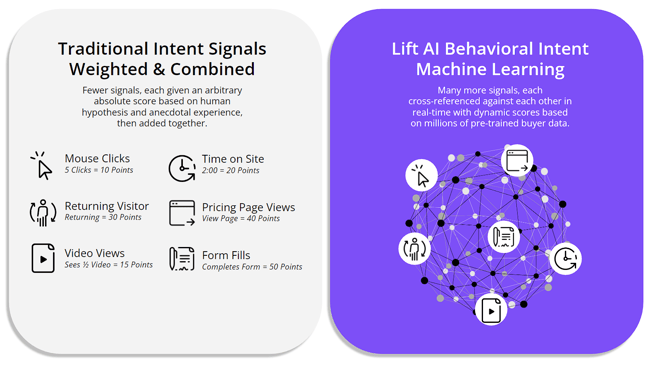
Most marketers don’t have a lead problem. They have a timing problem.
Someone downloads a white paper, and three follow-ups later, nothing happens. Why? Because they weren’t ready - they were just browsing. The real buying signals happened weeks earlier, somewhere else: a spike in competitor research, a series of comparison queries, a few quiet return visits to your site. You just didn’t see it.
That’s where predictive buyer intent steps in. Powered by AI in B2B marketing, it pieces together the “digital breadcrumbs” that prospects leave behind and not just on your site, but across the entire web. These are the subtle buyer intent signals that indicate who’s moving, how quickly, and where they are in their decision-making process.
The beauty of it? AI doesn’t just collect data; it connects dots. It learns what real purchase momentum looks like, so you can engage when intent is peaking, not after the fact. In other words, predictive intent turns “I think they’re interested” into “I know they’re ready.”
What Predictive Buyer Intent Actually Means
Let’s be clear: predictive buyer intent isn’t about chasing more data; it’s about understanding behavior at a depth humans can’t see.
Most teams still rely on a scoring model built around assumptions. Someone visits your pricing page? +10 points. Downloads a PDF? +5. It’s tidy, but it’s guesswork. Those models treat every buyer like they follow the same linear journey (which they don’t).

Image source: LiftAI
AI flips that logic. Instead of applying arbitrary scores, it studies patterns: how thousands of real buyers transitioned from curiosity to purchase, and what signals consistently appeared before a deal closed. Then it uses that pattern recognition to identify the same signals occurring in your pipeline at the present time. That’s AI-driven intent prediction - recognizing not just activity, but momentum.
And this is where most marketers get tripped up: interest isn’t intent.
Interest is awareness. Someone’s learning, exploring, and collecting ideas.
Intent is movement. They’re narrowing options, looping in finance, comparing you against two competitors, and checking your integration page at 11 p.m.
You don’t need AI to see interest because Google Analytics will happily show you that. But you do need it to isolate intent, because those patterns are subtle and cross-channel: research activity spikes on third-party sites, repeat visits from the same company subnet, changes in content depth, or dwell time.
That’s the gap predictive systems close. They don’t replace human judgment, but they give it precision. They tell your team, “This account isn’t just looking; they’re leaning in.”
that no longer rely on guesswork.
From “Nice to Know” to “Need to Act” Data
Most marketers are drowning in “nice to know” data: dashboards full of engagement metrics that look impressive but don’t move the pipeline. Views, clicks, opens… they paint a picture, but not a forecast.
AI changes that by connecting past behavior to future outcomes. It examines what actually happened before a deal closed - the research patterns, content sequences, revisit frequency, and even the time gaps between interactions - and builds a behavioral fingerprint of readiness. Then it scans your active accounts for matching patterns.
For example, let’s say a buyer’s journey usually accelerates after they consume three specific pieces of content: a thought-leadership article, a comparison guide, and then a pricing page. AI automatically picks up on that sequence. When a new prospect mirrors that same path, the system flags them as a high-probability account, often before they’ve filled out a single form.
See also: How AI is Transforming the B2B Sales Pipeline
The Digital Breadcrumb Trail — Where AI Finds Its Clues
Every prospect leaves a trail; you just need to know where to look.
AI excels at connecting those scattered buyer intent signals into a coherent story. Instead of treating each interaction in isolation, it reads behavior across channels, platforms, and timelines to determine which accounts are warming up and which are fading out.
Here’s where the strongest AI intent data usually comes from:
- Third-party intent data: Keyword surges, competitor engagement, and industry research patterns. For instance, if a company suddenly spikes activity around “cloud security compliance” or starts reading comparison reports on G2, it’s often a signal that something’s moving internally.
- Anonymous website traffic: Reverse IP lookups and enrichment tools turn nameless visits into company-level insights, telling you not just someone was on your pricing page, but who and how often.
- Competitor research: Visits to alternative vendor pages, pricing reviews, or third-party evaluator sites often precede a shift in vendor consideration.
- Content engagement: Frequency, dwell time, scroll depth, and topic clusters reveal how deep a company is in its research journey, from curiosity to conviction.
- CRM and internal data: Your own history matters. AI blends campaign data, SDR notes, and closed-won patterns to find which of your past signals predict the next deal.
Taken alone, these data points mean little. But once connected, they form a behavioral fingerprint that tells you who’s in-market and how close they are to making a purchase.
Why the Best Intent Models Blend Internal and External Data
You can’t predict the future using half the story.
Most teams either lean too heavily on external predictive intent data sources (like Bombora or 6sense) or rely solely on internal analytics. The real precision comes from combining the two.
When AI enriches your CRM with third-party signals, such as competitor searches, keyword activity, and review site visits, it creates a 360-degree view of account movement. Suddenly, that lead you thought had gone cold looks different: their company’s research activity is up 300%, and employees are comparing your category on LinkedIn.
That integration enables predictive re-engagement. For example, if the model learns that 70% of deals reignite within 90 days of a specific content trigger (say, a white paper revisit), it can flag dormant accounts that match that pattern. Instead of waiting for forms to fill out, your team gets a heads-up before the interest resurfaces.
See also: Close More Deals With AI-Driven Lead-to-Opportunity Scoring
|
Use AI to Focus on the 10% of Leads That Drive 90% of Revenue Predictive intent isn’t just another metric; it’s how modern marketers prioritize what matters. Talk to us and see how your team can move from chasing clicks to closing deals. Book a free strategy session today. |
From Clues to Conversions - How AI Predicts Buyer Readiness
Spotting buyer intent signals is only step one; the real magic is predicting what happens next.
That’s where AI buyer intent prediction turns insight into action. Machine learning models analyze millions of behavioral combinations and rank leads based on their probability of conversion, rather than arbitrary point systems, by statistically proven buying patterns.
-3.webp?width=650&height=340&name=HubSpot%20Content%20Hub%20for%20Marketers%20(6)-3.webp)
Image source: One IMS
Instead of asking “who clicked most,” predictive models ask:
- Who’s showing activity that matches past high-value buyers?
- What’s the likely time-to-contact window before a decision is made?
- Which channels and content formats increase close rates for this type of account?
This enables intent sequencing, where AI determines when outreach should occur, not just who to target. That timing precision fuels modern ABM strategies: triggering sales alerts, personalized ads, or content recommendations exactly when interest peaks.
The business impact is hard to ignore: shorter sales cycles, better win rates, and cleaner pipelines. Marketing stops flooding sales with “leads”; it delivers a prioritized list of accounts ready to move, ranked by conversion probability, not by activity volume.
What Human Intuition Misses That AI Doesn’t
Human instinct is great for nuance, but terrible for scale. A marketer might sense when a deal’s heating up, but only after dozens of interactions. AI sees it much sooner.
It detects hidden behavioral correlations no one’s watching for.
For example, companies that read competitor blog posts and revisit your demo page within a week tend to close within 30 days. Or, prospects who compare two specific integration pages often already have budgets approved. Humans won’t catch those links, but AI will.
And the more data you feed it, the smarter it gets. Predictive models evolve continuously, adjusting their weights and thresholds as buying patterns shift.
|
Turn Buyer Intent into Predictable Revenue See how AI-driven intent detection helps marketing teams focus on accounts that actually convert. Book a quick consultation with our team and discover where predictive insights can unlock your next growth surge. |
Differentiating Interest from Purchase Intent
Not all engagement means intent, and most pipelines get cluttered because teams treat every signal as a buying cue.
A webinar sign-up, an ebook download, or a white paper view might look encouraging, but these are vanity metrics, not indicators of purchase readiness. Real buyer intent signals show consistency and direction - the kind of activity that compounds across time and channels.

Image source: OneUpWeb
AI helps marketers separate curiosity from commitment. It tracks what happened and measures how often, how recently, and how deeply. A single visit to your pricing page isn’t meaningful. But multiple visits from the same company subnet within a week, paired with research on comparison sites and activity from other stakeholders in that account, that’s intent worth acting on.
This is where the accuracy of intent data matters most. AI validates signals by analyzing three dimensions:
- Frequency: how often behaviors repeat (isolated actions rarely predict conversion).
- Recency: how close those actions are to one another (compressed timeframes signal urgency).
- Depth: how advanced the content or interaction is (e.g., moving from thought-leadership to ROI calculators).
Then comes cross-signal correlation: combining digital behavior with firmographics (company size, industry, tech stack) and content journey stage. The result is an intent model that can tell whether a company is still exploring or actively evaluating solutions.
For instance:
A mid-market SaaS company reading your introductory blog posts might just be researching.
A week later, their product lead downloads your integration documentation, and two more people from the same domain visit your pricing page.
That pattern isn’t “interest.” That’s decision-making intent, and AI can spot it long before sales sees it in the CRM.
Why Over-Scoring Kills Efficiency
Ironically, one of the biggest risks of advanced AI lead qualification is overconfidence. If every warm behavior gets labeled as “intent,” your sales team burns hours chasing ghosts.
Setting the right thresholds is key. Predictive models should segment activity into distinct layers - awareness, consideration, and purchase - rather than a single catch-all “hot lead” bucket. Think of it as calibrating a radar: too sensitive, and it pings constantly; too strict, and you miss the real signals.
AI should enable precision, not pressure. When thresholds are tuned properly, marketing sends fewer leads, but with much higher hit rates, keeping sales focused and motivated rather than fatigued.
See also: Using AI for B2B Market Research & Competitive Intelligence
Implementing Predictive Intent in Your Marketing Stack
AI-powered intent isn’t plug-and-play; it’s a system that only works as well as the data feeding it. Here’s how to make sure it performs like an asset, not a distraction.
Start with clean data. Your CRM should be free of duplicates, stale records, and inconsistent tagging. Predictive models learn from historical inputs, so if your source data is messy, your predictions will be too.
Then, connect multiple intent data sources. Platforms like 6sense, Bombora, Breeze and Demandbase all analyze different aspects of the digital footprint, including external content consumption, keyword surges, and ad engagement. The real advantage comes when you combine them with your own first-party data (website visits, email engagement, campaign responses).
Next, train and monitor your AI models. Even the best algorithms drift over time as buyer behavior evolves. That’s why human oversight matters: your ops or RevOps team should regularly review predictions, spot anomalies, and adjust weighting.
Finally, track success metrics that matter:
- Conversion lift: how much faster leads are converting post-AI adoption.
- CAC reduction: whether cost per acquisition drops as targeting improves.
- Pipeline velocity: how much faster opportunities move through stages once intent is recognized early.
Those indicators prove the value of predictive lead scoring platforms better than any model accuracy score ever will.
The Right Time to Invest in Predictive Intent Tech
Not every organization needs predictive intent right away, and that’s okay. The best time to invest is when your lead volume or buying cycles make manual prioritization impossible.
If your sales team spends hours debating which accounts to call first, or your pipeline is filled with “maybe later” leads that never close, that’s a sign your process has outgrown gut instinct. Similarly, if your average deal involves multiple stakeholders and lengthy evaluation windows, predictive intent data can provide your team with a much-needed early warning system.
Conclusion: AI as the New Revenue Radar
The real promise of predictive buyer intent with AI isn’t automation; it’s accuracy. It strips out the noise, the guesswork, and the “maybe later” leads that clog your funnel. What’s left is clarity: who’s moving, how fast, and when to step in.
The best teams aren’t chasing leads anymore, but reading patterns. They’re using AI to visualize the next quarter’s pipeline before it forms, enabling a shift from reactive marketing to proactive revenue. That foresight turns marketing from a cost center into a growth engine.
AI buyer intent prediction is fast becoming the quiet edge behind every dominant sales org. Not because it replaces intuition, but because it makes intuition data-driven.
|
Not Sure Where AI Fits in Your Revenue Strategy? Talk to our team about where predictive intent creates the biggest ROI. From lead scoring to ABM targeting, we’ll pinpoint where AI can cut waste and accelerate wins. Book a free strategy session with our team. |
FAQs
What is predictive buyer intent with AI?
It’s how marketing and sales teams utilize AI to identify when accounts are transitioning from research to readiness. Instead of waiting for form fills or inbound triggers, AI identifies patterns, such as repeat visits, keyword surges, or multi-stakeholder engagement, that suggest a deal is imminent.
How is AI buyer intent prediction different from traditional lead scoring?
Old-school scoring assigns points to actions. AI looks for relationships between actions. It learns which combinations of signals have historically led to a sale and constantly adjusts as buyer behavior shifts, eliminating the need for manual rule updates and guesswork.
Which tools are leading in AI intent data?
Platforms like 6sense, Bombora, and Demandbase have set the standard for large teams. However, newer players like Lift AI and Instantly AI make intent tracking accessible to smaller organizations, combining behavioral analytics with predictive scoring that syncs into CRMs or ABM platforms.
Can small teams use predictive intent without big enterprise tools?
Absolutely. You don’t need a six-figure tech stack; you need clean data and clear criteria. Start with native AI insights in tools like HubSpot, LinkedIn, or Clay. The point isn’t scale; it’s precision.
How does predictive intent data improve sales and marketing alignment?
LIt gives both sides a single source of truth. Marketing stops guessing who’s warm; sales stops wasting time on cold outreach. Everyone works from the same data-backed signal of intent, and suddenly the handoff between the two feels seamless.





